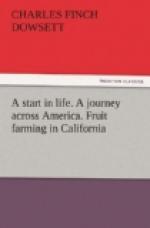OLIVE CULTURE.
“The growth of the olive is to be, it seems to me, one of the leading and most permanent industries of Southern California. It will give us, what it is nearly impossible to buy now, pure olive oil, in place of the cotton seed and lard mixture in general use. It is a most wholesome and palatable article of food. Those whose chief experience of the olive is the large, coarse, and not agreeable Spanish variety, used only as an appetizer, know little of the value of the best varieties as food, nutritious as meat, and always delicious. Good bread and a dish of pickled olives make an excellent meal. A mature olive grove in good bearing is a fortune. I feel sure that within 25 years this will be one of the most profitable industries of California, and that the demand for pure oil and edible fruit in the United States will drive out the adulterated and inferior present commercial products.”
SPECIAL OPENINGS.
There are now at Merced special openings for a nurseryman and a dairyman; the latter would be by growing alfalfa (lucerne) and raising poultry for at present the Merced people often have to get poultry and eggs from San Francisco, 150 miles off.
POTATO GROWING.
A settler might make a really good return out of potatoes while his Fruit trees are maturing, which is a food more in use in America than in England. Potatoes are not only served at luncheon and dinner, but also at breakfast everywhere, and, if every settler planted his land with potatoes, there would be no fear of overstocking the market.
Mr. Eisen states that potatoes yield from 50 to 400 sacks to the acre, and sell at prices varying from 90 cents to 2 dollars per sack. If only 50 sacks were grown to the acre, it would show a scarce year, when prices would range higher, but the crop is never a failure in California. Two crops can be grown in a year; the first crop is planted at the end of February, if warm, or else in March, or indeed any time till the middle of May, and dug three months after; the second crop is planted in August or September, and dug three months after.
To put in the potatoes a settler would need the help of a labourer, to whom he would have to give one dollar per day and his board, or, if the labourer be a Chinaman, one dollar and a quarter per day without his board. If the potatoes occupied ten acres, and they produced say 200 sacks to the acre, and fetched 1 dollar per sack, that would yield 2,000 dollars, or for the two crops 4,000 dollars, or, say, L800. This sounds a large sum, but the land is exceedingly rich, as may be seen from the samples I have brought back, and large results may be expected from it if properly worked, for, of course, in any undertaking the result depends upon the way it is worked.
The following paragraph is from an important paper or periodical of 20 pages, known as the Pacific Rural Press, of December 13th, 1890, and although the crop it mentions was not grown in California, it shows at least what can be done on good ground:—




